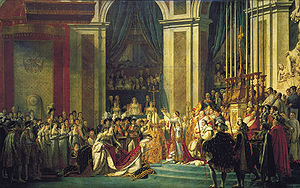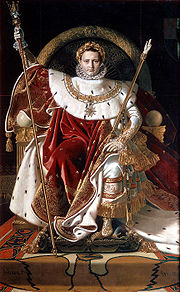
Crown of Napoleon
Encyclopedia
The Crown of Napoleon was a coronation crown
manufactured for Emperor Napoleon I of the French and used in his coronation
on December 2, 1804. Napoleon called his new crown the Crown of Charlemagne
, the name of the ancient royal coronation crown of France that had been destroyed in the French Revolution
, a name which allowed him to compare himself to the famed mediæval monarch Charlemagne
, King of the Franks
and Holy Roman Emperor
.
 The French Revolution
The French Revolution
of the 1790s had led to the destruction of most of the ancient French Crown Jewels
along with the eventual abolition of the French monarchy and the execution of King Louis XVI
and Queen Marie Antoinette
.
When Napoleon I declared himself French Emperor a decade later he decided to create new Imperial regalia
, the centrepiece of which was his Charlemagne crown.
 In the coronation itself, which took place not in the traditional location of French royal coronations, the Cathedral
In the coronation itself, which took place not in the traditional location of French royal coronations, the Cathedral
in Reims
, but in Notre Dame
in Paris
, he actually used two crowns. Initially he placed a laurel crown of the Roman emperor
s on his own head. Afterward he briefly placed the imperial Charlemagne crown on his head, then touched it to the head of his empress, Josephine.
an crowns, Napoleon's crown is made up of eight half-arches set with cameos which meet at a golden globe, on top of which is placed a cross.
The crown itself is mock mediæval in style, reliant totally on gold and metallic decoration and devoid of the major covering with diamonds and jewels fashionable in crowns made later in the 19th century.
, brother of Louis XVI, was installed on the throne as King of France following Napoleon's overthrow. In contrast both to his brother and to Napoleon, the new king opted not to have a coronation. When his brother, Charles X
became king in 1824, he reinstated the traditional monarchical coronation in Reims and was crowned using the remaining pre-revolutionary French royal crown, the Crown of Louis XV
. No more French coronations, either imperial or royal, followed Charles X's overthrow in 1830.
When Napoleon III proclaimed himself French emperor in 1852 he opted to neither have a coronation nor wear Napoleon I's crown. Nevertheless, a crown was created for Empress Eugenie
, the Crown of Empress Eugenie
.
museum in Paris
.
Coronation crown
A coronation crown is a crown used by a monarch when being crowned. In some monarchies, monarchs did not wear the one crown but had a number of crowns for different occasions; a coronation crown for the moment of coronation, and a state crown for general usage in state ceremonial...
manufactured for Emperor Napoleon I of the French and used in his coronation
Coronation
A coronation is a ceremony marking the formal investiture of a monarch and/or their consort with regal power, usually involving the placement of a crown upon their head and the presentation of other items of regalia...
on December 2, 1804. Napoleon called his new crown the Crown of Charlemagne
Crown of Charlemagne
The Crown of Charlemagne was the ancient coronation crown of Kings of the Franks, and later Kings of France after 1237. It was probably originally made as a simple circlet of four curved rectanglar jewelled plates for Charles the Bald, but later, four large jewelled fleur-de-lis were added to...
, the name of the ancient royal coronation crown of France that had been destroyed in the French Revolution
French Revolution
The French Revolution , sometimes distinguished as the 'Great French Revolution' , was a period of radical social and political upheaval in France and Europe. The absolute monarchy that had ruled France for centuries collapsed in three years...
, a name which allowed him to compare himself to the famed mediæval monarch Charlemagne
Charlemagne
Charlemagne was King of the Franks from 768 and Emperor of the Romans from 800 to his death in 814. He expanded the Frankish kingdom into an empire that incorporated much of Western and Central Europe. During his reign, he conquered Italy and was crowned by Pope Leo III on 25 December 800...
, King of the Franks
Franks
The Franks were a confederation of Germanic tribes first attested in the third century AD as living north and east of the Lower Rhine River. From the third to fifth centuries some Franks raided Roman territory while other Franks joined the Roman troops in Gaul. Only the Salian Franks formed a...
and Holy Roman Emperor
Holy Roman Emperor
The Holy Roman Emperor is a term used by historians to denote a medieval ruler who, as German King, had also received the title of "Emperor of the Romans" from the Pope...
.
Origins

French Revolution
The French Revolution , sometimes distinguished as the 'Great French Revolution' , was a period of radical social and political upheaval in France and Europe. The absolute monarchy that had ruled France for centuries collapsed in three years...
of the 1790s had led to the destruction of most of the ancient French Crown Jewels
French Crown Jewels
The French Crown Jewels were the crowns, orb, sceptres, diadems and jewels that were the symbol of royalty and which were worn by many Kings and Queens of France. The set was finally broken up, with most of it sold off in 1885 by the Third French Republic...
along with the eventual abolition of the French monarchy and the execution of King Louis XVI
Louis XVI of France
Louis XVI was a Bourbon monarch who ruled as King of France and Navarre until 1791, and then as King of the French from 1791 to 1792, before being executed in 1793....
and Queen Marie Antoinette
Marie Antoinette
Marie Antoinette ; 2 November 1755 – 16 October 1793) was an Archduchess of Austria and the Queen of France and of Navarre. She was the fifteenth and penultimate child of Holy Roman Empress Maria Theresa and Holy Roman Emperor Francis I....
.
When Napoleon I declared himself French Emperor a decade later he decided to create new Imperial regalia
Regalia
Regalia is Latin plurale tantum for the privileges and the insignia characteristic of a Sovereign.The word stems from the Latin substantivation of the adjective regalis, 'regal', itself from Rex, 'king'...
, the centrepiece of which was his Charlemagne crown.
Usage

Cathedral
A cathedral is a Christian church that contains the seat of a bishop...
in Reims
Reims
Reims , a city in the Champagne-Ardenne region of France, lies east-northeast of Paris. Founded by the Gauls, it became a major city during the period of the Roman Empire....
, but in Notre Dame
Notre Dame de Paris
Notre Dame de Paris , also known as Notre Dame Cathedral, is a Gothic, Roman Catholic cathedral on the eastern half of the Île de la Cité in the fourth arrondissement of Paris, France. It is the cathedral of the Catholic Archdiocese of Paris: that is, it is the church that contains the cathedra of...
in Paris
Paris
Paris is the capital and largest city in France, situated on the river Seine, in northern France, at the heart of the Île-de-France region...
, he actually used two crowns. Initially he placed a laurel crown of the Roman emperor
Roman Emperor
The Roman emperor was the ruler of the Roman State during the imperial period . The Romans had no single term for the office although at any given time, a given title was associated with the emperor...
s on his own head. Afterward he briefly placed the imperial Charlemagne crown on his head, then touched it to the head of his empress, Josephine.
Design
As was the norm with EuropeEurope
Europe is, by convention, one of the world's seven continents. Comprising the westernmost peninsula of Eurasia, Europe is generally 'divided' from Asia to its east by the watershed divides of the Ural and Caucasus Mountains, the Ural River, the Caspian and Black Seas, and the waterways connecting...
an crowns, Napoleon's crown is made up of eight half-arches set with cameos which meet at a golden globe, on top of which is placed a cross.
The crown itself is mock mediæval in style, reliant totally on gold and metallic decoration and devoid of the major covering with diamonds and jewels fashionable in crowns made later in the 19th century.
After the Empire
The Crown of Napoleon was used until his second overthrow in 1815. King Louis XVIIILouis XVIII of France
Louis XVIII , known as "the Unavoidable", was King of France and of Navarre from 1814 to 1824, omitting the Hundred Days in 1815...
, brother of Louis XVI, was installed on the throne as King of France following Napoleon's overthrow. In contrast both to his brother and to Napoleon, the new king opted not to have a coronation. When his brother, Charles X
Charles X of France
Charles X was known for most of his life as the Comte d'Artois before he reigned as King of France and of Navarre from 16 September 1824 until 2 August 1830. A younger brother to Kings Louis XVI and Louis XVIII, he supported the latter in exile and eventually succeeded him...
became king in 1824, he reinstated the traditional monarchical coronation in Reims and was crowned using the remaining pre-revolutionary French royal crown, the Crown of Louis XV
Crown of Louis XV
The Crown of Louis XV is the sole surviving crown from the French ancien regime among the French Crown Jewels.- History :Until the beginning of the 18th century French kings wore plain crowns unembellished with precious stones. This was changed by King Louis XV in 1722, when he had a new crown...
. No more French coronations, either imperial or royal, followed Charles X's overthrow in 1830.
When Napoleon III proclaimed himself French emperor in 1852 he opted to neither have a coronation nor wear Napoleon I's crown. Nevertheless, a crown was created for Empress Eugenie
Eugénie de Montijo
Doña María Eugenia Ignacia Augustina de Palafox-Portocarrero de Guzmán y Kirkpatrick, 16th Countess of Teba and 15th Marquise of Ardales; 5 May 1826 – 11 July 1920), known as Eugénie de Montijo , was the last Empress consort of the French from 1853 to 1871 as the wife of Napoleon III, Emperor of...
, the Crown of Empress Eugenie
Crown of Empress Eugenie
The Crown of Empress Eugénie was the consort crown of Eugénie de Montijo, the empress consort of Emperor Napoleon III of France. Though neither she nor her husband underwent a coronation a consort crown was specially created for her....
.
Sale of the French Crown Jewels
In 1885, to impede any further attempts at royal or imperial restorations, the French National Assembly opted to sell most of the French Crown Jewels. Only a handful of crowns were kept for historic reasons, and they had their precious jewels replaced in them by decorated glass. Napoleon I's crown was one of the few kept. It is now on display in the LouvreLouvre
The Musée du Louvre – in English, the Louvre Museum or simply the Louvre – is one of the world's largest museums, the most visited art museum in the world and a historic monument. A central landmark of Paris, it is located on the Right Bank of the Seine in the 1st arrondissement...
museum in Paris
Paris
Paris is the capital and largest city in France, situated on the river Seine, in northern France, at the heart of the Île-de-France region...
.

